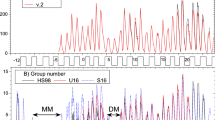Abstract
Our purpose is to find which is the most reliable one among various oxygen abundance determination methods. We will test the validity of several different oxygen abundance determination methods using methods of modern statistics. These methods include Bayesian analysis and information scoring. We will analyze a sample of ∼ 6000 Hii galaxies from the Sloan Digital Sky Survey (SDSS) spectroscopic observations data release four. All methods that we used drew the same conclusion that the T e method is a more reliable oxygen abundance determination method than the Bayesian metallicity method under the existing telescope ability. The ratios of the likelihoods between the different kinds of methods tell us that the T e , P, and O3N2 methods are consistent with each other because the P and O3N2 methods are calibrated by T e method. The Bayesian and R 23 methods are consistent with each other because both are calibrated by a galaxy model. In either case, the N2 method is an unreliable method.
Similar content being viewed by others
References
Akaike, H. 1973, Information theory and an extension of the maximum likelihood principle; In: Second International Symposium on Information Theory (eds) Petrov, B. N., Csaki, F., Academiai Kiado, Budapest, pp. 267–281.
Alloin, D., Collin-Souffrin, S., Joly, M., Vigroux, L. 1979, A&A, 78, 200.
Bozdogan, H. 1990, On the Information-Based Measure of Covariance Complexity and its Application to the Evaluation of Multivariate Linear Models, Communications in Statistics, Theory and Methods, A19(1), 221–278.
Bozdogan, H. 2004, Statistical Data Mining and Knowledge Discovery, Chapman and Hall/CRC, Boca Raton, Florida, 15–56.
Charlot, S., Fall, S. M. 2000, ApJ, 539, 718C.
Charlot, S., Longhetti, M. 2001, MNRAS, 323, 887.
Contini, T., Treyer, M. A., Sullivan, M., Ellis, R. S. 2002, MNRAS, 330, 75.
Denicoló, G., Terlevich, R., Terlevich, E. 2002, MNRAS, 330, 69.
Dong, X.-B., Zhou, H.-Y., Wang, T.-G., Wang, J.-X., Li, C., Zhou, Y.-Y. 2005, ApJ, 620, 629.
Ferland, G. J., Korista, K. T., Verner, D. A., Ferguson, J.W., Kingdon, J. B., Verner, E.M. 1998, PASP, 110, 761.
Izotov, Y. I., Stasińska, G., Meynet, G., Guseva, N. G., Thuan, T. X. 2006, A&A, 448, 955.
Kauffmann, G. et al. 2003, MNRAS, 346, 1055.
Kennicutt, R. C. 1998, ARA&A, 36, 189.
Kewley, L. J., Dopita, M. A. 2002, ApJS, 142, 35.
Kewley, L. J., Jansen, R. A., Geller, M. J. 2005, PASP, 117, 227.
Kobulnicky, H. A., Kennicutt, R. C. Jr., Pizagno, J. L. 1999, ApJ, 514, 544.
Li, C. et al. 2005, AJ, 129, 669.
Liang, Y. C., Yin, S. Y., Hammer, F., Deng, L. C., Flores, H., Zhang, B. 2006, ApJ, 652, 257.
Lu, H., Zhou, H., Wang, J., Wang, T., Dong, X., Zhuang, Z., Li, C. 2006, AJ, 131, 790.
Magueijo, J., Sorkin, R. D. 2007, MNRAS, 377, L39.
McGaugh, S. S. 1991, ApJ, 380, 140.
Nagao, T., Maiolino, R., Marconi, A. 2006, A&A, 459, 85.
Pagel, B. E. J., Edmunds, M. G., Blackwell, D. E. et al. 1979, MNRAS, 189, 95.
Pettini, M., Pagel, B. E. J. 2004, MNRAS, 348, L59.
Pilyugin, L. S. 2000, A&A, 362, 325.
Pilyugin, L. S. 2001, A&A, 369, 594.
Pilyugin, L. S., Thuan, T. X. 2005, ApJ, 631, 231.
de Robertis, M. M., Dufour, R. J., Hunt, R. W. 1987, JRASC, 81, 195.
Shaw, R. A., Dufour, R. J. 1995, PASP, 107, 896.
Shi, F., Kong, X., Li, C., Cheng, F. Z. 2005, A&A, 437, 849.
Shi, F., Kong, X., Cheng, F. Z. 2006, A&A, 453, 487.
Shi, F., Zhao, G., Liang, Y. C. 2007, A&A, 475, 409.
Stasińska, G., Leitherer, C. 1996, ApJS, 107, 661.
Stasińska, G. 2005, A&A, 434, 507.
Stasińska, G. 2006, A&A, 454, L127.
Tremonti et al. 2004, ApJ, 613, 898T.
Yin, S. Y., Liang, Y. C., Hammer, F., Brinchmann, J., Zhang, B., Deng, L. C., Flores, H. 2007, A&A, 462, 535.
York, D. G., Hall, P. B. et al. 2001, AJ, 122, 549.
Author information
Authors and Affiliations
Corresponding author
Rights and permissions
About this article
Cite this article
Shi, F., Zhao, G. & Wicker, J. Oxygen abundance methods in SDSS: View from modern statistics. J Astrophys Astron 31, 121–133 (2010). https://doi.org/10.1007/s12036-010-0011-z
Received:
Accepted:
Published:
Issue Date:
DOI: https://doi.org/10.1007/s12036-010-0011-z




